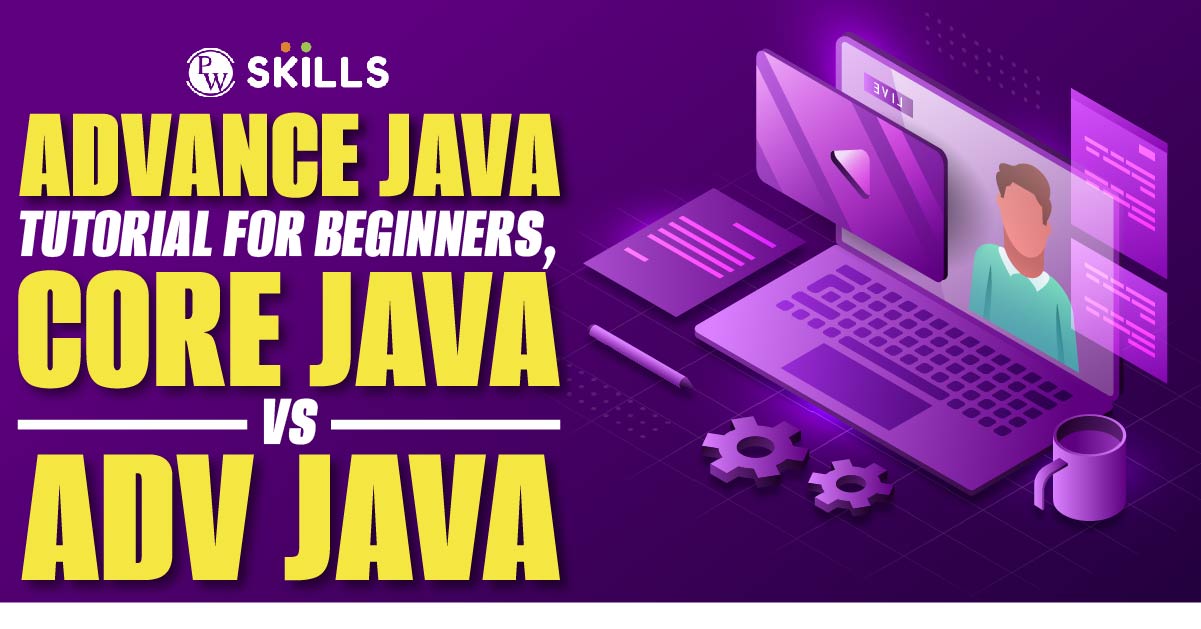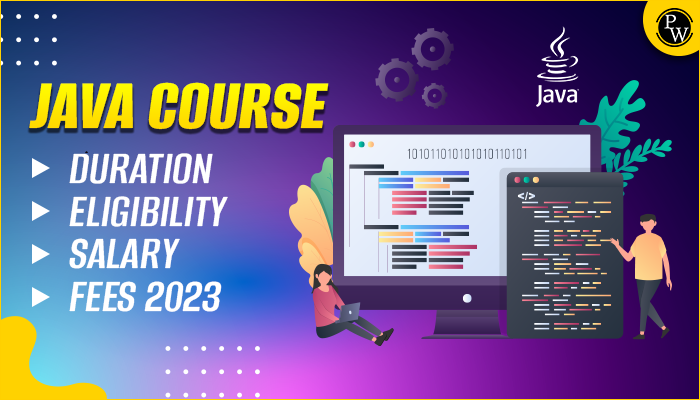If you’re looking for Adv Java tutorial, then you’re at the right place. In this blog, we’ll teach you everything you need to know about Advanced Java, core Java, its definition, language, and more!
Adv Java Tutorial: Java programming language (JEE) comprises Core Java (J2SE) and Advanced Java as its two integral components. The fundamentals of the Java programming language, encompassing data types, functions, operators, loops, threads, and exception handling, are covered in the “core Java” segment of this book.
Utilised in the creation of applications for extensive use, Core Java serves as the foundation. On the other hand, Advanced Java delves into more sophisticated topics, including database connection, networking, Servlet, web services, and the like, addressing more fundamental concepts. In this article, we’ll talk about adv Java tutorial, language, and definition, and delve into its core ideas.

If you want to make a successful career in Full Stack Web Development, the PhysicsWallah’s Full Stack Web Development course is just what you need! Our course will teach you everything you need to know to succeed as a full-stack web developer in 2024. So, don’t wait, apply the coupon code READER and get an exclusive discount on all courses from PW Skills.
Advanced Java Definition
Advanced Java refers to an elevated level of proficiency and expertise in Java programming beyond the fundamentals. It encompasses a spectrum of advanced concepts and techniques designed to empower developers in building complex, high-performance applications. Key elements include multithreading, networking, database connectivity, and advanced frameworks like Spring and Hibernate.
Advanced Java also explores design patterns, architectural principles, and enterprise-level development, enabling developers to create scalable, maintainable, and efficient solutions. This specialisation is crucial for professionals aiming to tackle real-world challenges, such as large-scale enterprise applications or distributed systems.
Mastery of Advanced Java opens doors to harnessing the language’s full potential, fostering better software design, and navigating the intricate landscape of modern Java development. It’s an essential skill set for developers seeking to elevate their coding capabilities and tackle sophisticated projects in the dynamic realm of software engineering.
Advanced Java Language
Advanced Java, beyond its foundational concepts, comprises a sophisticated set of programming principles and techniques for building robust, scalable, and enterprise-level applications. It includes advanced topics such as multithreading, networking, database connectivity, and frameworks like Spring and Hibernate.
Multithreading allows the concurrent execution of multiple threads, enhancing performance in applications that require parallel processing. Networking facilitates communication between applications over a network, a crucial aspect in distributed systems.
Database connectivity involves integrating Java applications with databases, ensuring seamless data storage and retrieval. Advanced Java also encompasses design patterns, guiding developers in creating efficient and maintainable code structures.
Mastery of these concepts is essential for developers tackling complex projects, providing them with the tools to design scalable and high-performance solutions in the ever-evolving landscape of software development.
Also Read: Step-by-Step Guide to Becoming a Java Architect in 2024
Advanced Java Programming
Advanced Java programming extends beyond basic language features and syntax, focusing on intricate concepts and methodologies to develop sophisticated applications. It involves a deep understanding of topics such as multithreading, enabling the simultaneous execution of multiple threads to enhance performance in complex systems.
Networking in advanced Java allows seamless communication between applications, crucial for building distributed and interconnected systems. Database connectivity involves integrating Java applications with databases, ensuring efficient data storage and retrieval mechanisms.
Advanced Java also encompasses the usage of frameworks like Spring and Hibernate, streamlining development processes and promoting best practices in building enterprise-level applications. Additionally, the understanding of design patterns becomes crucial for creating scalable, maintainable, and adaptable code structures.
Overall, advanced Java programming equips developers with the knowledge and skills to address challenges in large-scale software development, enabling the creation of robust and efficient solutions.
Advanced Java Programming Tutorial
Here’s a detailed advanced Java programming tutorial:
- Foundation Understanding: Before diving into Advanced Java, ensure a solid grasp of core Java concepts such as object-oriented programming, data types, control structures, and basic syntax.
- Object-Oriented Principles: Deepen your understanding of object-oriented programming (OOP) principles like encapsulation, inheritance, and polymorphism, as they form the backbone of Java development.
- Threading Concepts: Learn the fundamentals of multithreading, a key feature in Advanced Java. Comprehend how threads work concurrently to improve application performance.
- Networking Basics: Explore networking concepts to understand communication between applications over a network. This is crucial for building distributed systems.
- Database Connectivity: Delve into advanced database connectivity to seamlessly integrate Java applications with databases. Understand concepts like JDBC (Java Database Connectivity) for efficient data management.
- Advanced Frameworks: Familiarise yourself with popular frameworks like Spring and Hibernate. These tools simplify complex tasks in enterprise-level development, offering features such as dependency injection and object-relational mapping.
- Design Patterns: Study design patterns to enhance your software architecture skills. Understand common patterns like Singleton, Observer, and Factory, which contribute to scalable and maintainable code.
- Error Handling and Exception Management: Learn advanced techniques for error handling and exception management. Understand how to handle exceptional scenarios gracefully for robust applications.
- Security Concepts: Gain insights into security practices within Java applications. Understand how to implement secure coding practices and protect against common vulnerabilities.
- Performance Optimization: Explore strategies for optimising application performance. This involves profiling, tuning, and employing best practices to ensure your Java applications run efficiently.
- Advanced I/O Operations: Extend your knowledge of input/output operations. Learn about advanced I/O streams and file handling for more sophisticated data manipulation.
- Continuous Learning and Community Engagement: Stay updated on the latest trends and advancements in Advanced Java. Engage with the Java community, participate in forums, and follow reputable blogs to stay informed.
By following these steps, you can systematically progress through Advanced Java without focusing on specific code implementations, building a comprehensive understanding of the language’s advanced features and applications.
Adv Java Tutorial
Follow these steps for Adv Java tutorial:
Step 1: Foundational Knowledge: Ensure a strong understanding of core Java concepts, including object-oriented programming, data types, control structures, and basic syntax.
Step 2: Object-Oriented Principles: Deepen your grasp of advanced object-oriented programming principles like encapsulation, inheritance, and polymorphism, essential for creating scalable and maintainable code.
Step 3: Multithreading: Learn the fundamentals of multithreading, understanding how to create and manage concurrent threads to improve application performance.
Step 4: Networking: Explore networking concepts to facilitate communication between applications, crucial for building distributed systems and connecting clients and servers.
Step 5: Database Connectivity: Gain proficiency in connecting Java applications to databases using JDBC (Java Database Connectivity) to store and retrieve data efficiently.
Step 6: Frameworks (Spring, Hibernate): Familiarise yourself with advanced frameworks like Spring for dependency injection and Hibernate for object-relational mapping, streamlining development in enterprise-level applications.
Step 7: Design Patterns: Study common design patterns such as Singleton, Factory, and Observer to enhance your ability to create scalable and maintainable software architectures.
Step 8: Exception Handling: Deepen your understanding of Java’s exception handling mechanisms to write robust and error-tolerant code.
Step 9: Collections and Generics: Explore advanced usage of collections and generics to manage and manipulate data structures effectively.
Step 10: Testing and Debugging Techniques: Learn advanced testing methodologies and debugging techniques to ensure the reliability and stability of your Java applications.
Step 11: Continuous Learning: Stay updated on the latest trends and advancements in the
Java ecosystem to adapt to evolving best practices and tools.
By following these steps, you’ll develop a comprehensive skill set in advanced Java programming, enabling you to build sophisticated and efficient applications.
Also Read: Top 10 Libraries every Java Developer should know
Adv Java Tutorial for Beginners
Understanding Advanced Java is not that easy for beginners. So, here are the detailed steps for Adv Java tutorial for beginners:
Step 1: Review Java Fundamentals: Ensure you have a solid understanding of basic Java concepts like variables, data types, loops, and functions.
Step 2: Object-Oriented Programming (OOP): Learn the principles of OOP, including classes, objects, inheritance, polymorphism, and encapsulation.
Step 3: Exception Handling: Understand how to handle exceptions gracefully to ensure robust and error-tolerant code.
Step 4: Multithreading: Explore the basics of multithreading to enable concurrent execution and enhance the performance of your applications.
Step 5: Database Connectivity with JDBC: Learn how to connect your Java applications to databases using JDBC for efficient data storage and retrieval.
Step 6: Networking Basics: Familiarise yourself with basic networking concepts to enable communication between different applications.
Step 7: Introduction to Spring Framework: Get started with the Spring framework, a powerful and widely used framework for building Java-based enterprise applications.
Step 8: Hibernate Basics: Understand the fundamentals of Hibernate, an ORM (Object-Relational Mapping) framework, for simplified database interactions.
Step 9: Introduction to Design Patterns: Explore common design patterns that help in creating scalable and maintainable code structures.
Step 10: Advanced Concepts: Delve into advanced topics such as Servlets, JSP (JavaServer Pages), and other technologies used in web development.
Step 11: Build a Project: Apply your knowledge by working on a small project, integrating various advanced Java concepts you’ve learned.
Step 12: Continuous Practice and Learning: Regularly practise coding and stay updated on the latest developments in the Java ecosystem.
This tutorial is designed to gradually introduce you to advanced Java concepts, providing a solid foundation for further exploration. Happy coding!
What is Advance Java?
The dictionary meaning of advance is a forward movement or a development or improvement and the meaning of improve means something that makes something better. All in all, we have to improve our basic knowledge to master that particular field.
Java is divided into two parts i.e. Core Java (J2SE) and Advanced Java (JEE). The core Java part covers the fundamentals (data types, functions, operators, loops, thread, exception handling, etc.) of the Java programming language. It is used to develop general purpose applications.
Whereas Advanced Java covers the standard concepts such as database connectivity, networking, Servlet, web-services, etc. In this section, we will discuss what advanced Java is, its benefits, uses, topics of advanced Java, and the difference between core Java and advanced Java.
It is a part of the Java programming language. It is an advanced technology or advanced version of Java specially designed to develop web-based, network-centric or enterprise applications. It includes concepts like Servlet, JSP, JDBC, RMI, Socket programming, etc. It is a specialisation in a specific domain.
Also Read: Difference Between Core Java and Advanced Java
How do I Start Learning Advanced Java?
If you want to start learning advanced Java, then you can follow these steps:
- Solid Foundation in Core Java: Ensure you have a strong understanding of core Java concepts, including variables, data types, control structures, and object-oriented programming (OOP) principles.
- Networking Basics: Understand the fundamentals of networking in Java. Explore concepts like sockets, TCP/IP, and UDP to enable communication between different applications.
- Servlets and JSP (JavaServer Pages): Get acquainted with web development using Servlets and JSP, which are essential components for building dynamic web applications in Java.
- Introduction to Spring Framework: Learn the basics of the Spring framework, a powerful and widely used framework for building enterprise-level Java applications. Focus on dependency injection, Spring MVC, and other core features.
- Hibernate Basics: Understand Hibernate, an Object-Relational Mapping (ORM) framework, for simplified database interactions. Learn how to map Java objects to database tables.
- Design Patterns: Explore common design patterns that help in creating scalable, maintainable, and efficient code structures. Examples include Singleton, Factory, Observer, and MVC patterns.
- Build Real-World Projects: Apply your knowledge by working on practical projects. This hands-on experience is crucial for reinforcing your skills and gaining confidence in using advanced Java concepts.
- Continuous Learning and Practice: Stay updated on the latest advancements in Java. Follow blogs, participate in forums, and engage in continuous coding practice to strengthen your skills.
- Explore Advanced Topics: Once comfortable with the basics, explore more advanced topics such as Spring Boot, microservices architecture, and cloud integration.
Remember, learning Advanced Java is a gradual process, so take your time to thoroughly understand each concept before moving on to the next. Utilise online tutorials, documentation, and coding exercises to reinforce your learning. Happy coding!
What is Core Java vs ADV Java?
Core Java and Adv Java may seem similar to each other but they differ a lot from each other. Here are some of the main differences between Core Java and Advanced Java:
| Aspect | Core Java | Advanced Java |
| Focus | Fundamental concepts of Java | Builds upon Core Java, covers advanced concepts |
| Scope | Basics, syntax, OOP principles | Multithreading, networking, frameworks, web development |
| Language Features | Basic syntax, data types, control structures | Advanced language features, multithreading, networking |
| OOP Principles | Introduces OOP (classes, objects, inheritance, polymorphism) | Builds on OOP, explores more advanced OOP concepts |
| Libraries | Java Standard Edition (SE) libraries | Additional libraries for advanced functionalities |
| Applications | General-purpose applications | Web development, enterprise-level applications |
| Technologies | Java SE | Java EE (Java Platform, Enterprise Edition) |
| Topics Covered | Basic language features, basic libraries | Multithreading, networking, database connectivity, web development, frameworks like Spring and Hibernate |
| Examples | Basic console applications | Web applications, enterprise solutions |
In summary, Core Java provides the foundation for Java programming, covering basic syntax, OOP principles, and the Java SE libraries. Advanced Java extends beyond the basics, encompassing more complex topics like multithreading, networking, web development, and advanced frameworks for enterprise-level applications.
Is Advanced Java Programming Hard?
The difficulty of advanced Java programming depends on your familiarity with core Java concepts and your experience in software development. Advanced Java introduces more intricate and specialised topics, making it challenging for beginners but manageable for those with a solid foundation.
Multithreading, networking, and frameworks like Spring and Hibernate add complexity, demanding a deeper understanding of how Java works at a more intricate level. The learning curve steepens as developers delve into web development with Servlets, JSP, and other technologies.
Moreover, the transition from writing basic console applications to building robust, scalable enterprise-level solutions requires a shift in mindset and skill set. Mastering advanced Java involves not only learning new concepts but also integrating them effectively to create efficient and maintainable code.
While challenging, the difficulty is also a testament to the power and versatility of Java in handling complex applications. Continuous practice, hands-on projects, and a commitment to ongoing learning are key to overcoming the challenges posed by advanced Java programming.
Also Read: 10 Essential Tools for Java Developers 2024
With dedication, patience, and a structured learning approach, developers can navigate the complexities and derive immense satisfaction from harnessing the full potential of Java in advanced software development.
Advanced Java programming presents a challenging yet rewarding journey. While mastering intricate concepts such as multithreading, networking, and frameworks may seem daunting, a solid foundation in core Java and persistent learning pave the way for success. The transition to building web applications and enterprise-level solutions requires commitment and practical application.
Career in Data Science FAQs
What is Core Java?
Core Java constitutes the fundamental aspects of Java programming, covering basic syntax, data types, and introducing essential Object-Oriented Programming (OOP) principles like inheritance and polymorphism.
Why Learn Advanced Java?
Advanced Java builds upon Core Java, offering deeper insights into multithreading, networking, and advanced frameworks like Spring and Hibernate. It is crucial for developing sophisticated web applications and enterprise-level solutions.
How Difficult is Multithreading in Java?
Multithreading in Java can be challenging for beginners due to the concurrent execution of multiple threads. Understanding synchronisation, thread safety, and potential issues are essential to mastering this advanced concept.
What is the Role of Servlets and JSP in Advanced Java?
Servlets and JavaServer Pages (JSP) are integral to web development in Advanced Java. Servlets handle server-side logic, while JSP simplifies the creation of dynamic content, making them vital for building robust web applications.
Why Use Frameworks like Spring and Hibernate?
Frameworks like Spring simplify Java development by providing features like dependency injection, making code modular and easier to maintain. Hibernate, an Object-Relational Mapping (ORM) framework, streamlines database interactions, enhancing the efficiency of Java applications.



